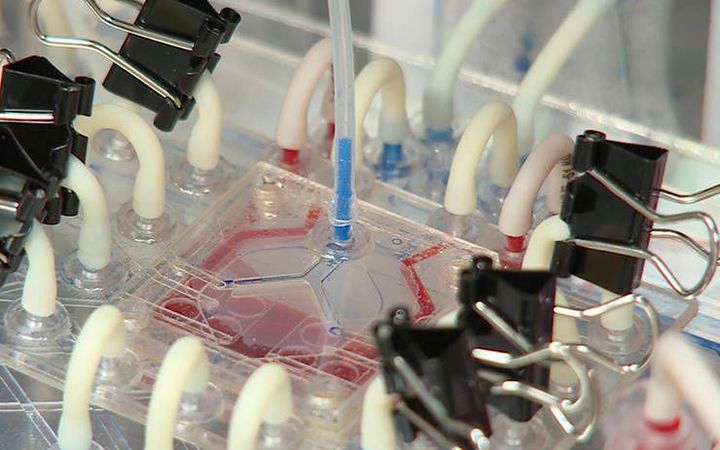
Scientists at Los Alamos National Laboratory are developing a miniature, tissue-engineered artificial lung that mimics the response of the human lung to drugs, toxins and other agents. Nicknamed “PuLMo” for Pulmonary Lung Model, the device consists of two major parts, the bronchiolar unit and the alveolar unit — just like the human lung.
When people talk about this being the century of biology, they look forward to more and more advances in our understanding of how life works — and the benefits that go with that understanding.
Biology has entered a phase where basic discoveries can be applied to a wide range of health problems. Whether the next breakthroughs come from genomic research into DNA, for instance, or new insights into how physics and chemistry underpin the mechanisms of life, they will have a dramatic, life-changing impact. We don’t know everything, but what we do know has given biologists and medical researchers impressive new powers.
A sign of biology’s maturity is the explosion of related technologies. Biotech is all around us, from pacemakers to gene editors, from continuous glucose monitors to wonderful new drugs that target cancer cells while leaving healthy ones alone. On one exciting new frontier in biotechnology, researchers are creating miniature, artificial human organs that function much like the real ones. Under the ATHENA research program, the Defense Threat Reduction Agency within the U.S. Department of Defense has funded work integrating miniature artificial hearts, livers, lungs and kidneys into surrogate human organ systems.
The agency supports this work to help develop countermeasures to chemical or biological warfare threats. In the early development phases, those countermeasures can’t ethically be tested on human populations. So these surrogate organs, which mimic the function and response of actual human organs, address a crucial problem: accurately predicting how humans will respond to a drug or toxin. For decades now, drug trials have relied on animals. Some drugs have passed animal trials only to fail — sometimes fatally — in human trials. A new lung model will allow researchers to observe a drug’s effects without endangering human subjects.
For their part in ATHENA, a team of scientists and bioengineers at Los Alamos National Laboratory have developed a tissue-engineered artificial lung called PuLMo, for Pulmonary Lung Model, that simulates the response of the human lung to drugs, toxins, particles and other agents. As an artificial organ that you can see inside, the laptop-sized device is a unique technological scaffold for building all kinds of life-improving research and technology.
Resembling an amped-up computer board sprouting tubes, wires, and clamps and using real human cells, PuLMo consists of a bronchiolar unit and an alveolar unit. They work the way a lung is supposed to work — PuLMo breathes. A microfluid circuit board manages the flow of fluids and air through each plastic unit. When cells are placed in PuLMo and fed the proper environment, they flourish as they would in the body.
The design accommodates a variety of cell types and tissues. This flexibility means any skilled researcher using PuLMo can test a wide range of conditions just by tweaking the variables, such as tissue and cell types, a drug, or a pathogen, one at a time. That’s impossible in the body but key to good science. And because PuLMo can be configured to suit the experiment, researchers decide which cells they want to study in mixed populations, an approach that’s faithful to how the human body works but difficult when cultures are isolated in a Petri dish. Every tissue in the body has multiple cell types, and they all provide nutrients and signals to each other. PuLMo replicates those conditions.
As PuLMo breathes, using realistic negative air pressure as our bodies do, researchers can study how particles and pathogens flow into the lung and are deposited there. That research can help improve the delivery of drugs. It can also shed light on the poorly understood effects of e-cigarettes, for example. And PuLMo can be configured to reproduce lung-disease conditions, such as Chronic Obstructive Pulmonary Disease and asthma.
With support from DTRA, Los Alamos works on this surrogate lung as part of its biosecurity research into protecting against biothreats and stopping the spread of disease. Combined with PuLMo’s exciting and far-reaching potential to raise the reliability of drug-toxicity assessments and predicting how new pharmaceuticals will perform in humans, PuLMo has the potential to save time, money, and — most crucially — lives, whether they are soldiers or citizens. That research requires an in-depth understanding of biological systems and their response to disease, pathogens, and chemicals — 21st century biology. By developing PuLMo, Los Alamos has pioneered an appropriate tool for making the century of biology a boon to everyone’s good health.
Jennifer Harris is a research biologist in the Biosecurity and Public Health group and Pulak Nath is an engineer in the Applied Modern Physics group at Los Alamos National Laboratory. PuLMo recently won an R&D 100 award from R&D Magazine. The prestigious “Oscars of Invention” honor the latest and best innovations and identify the top technology products of the past year.
